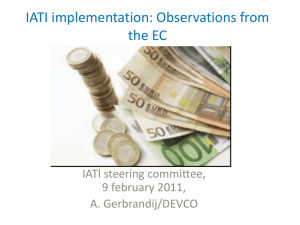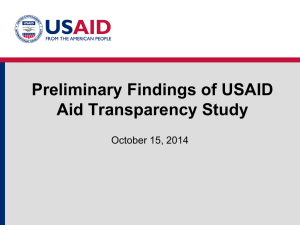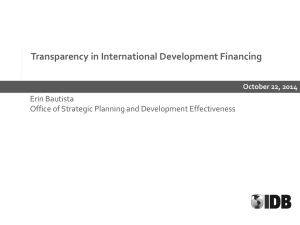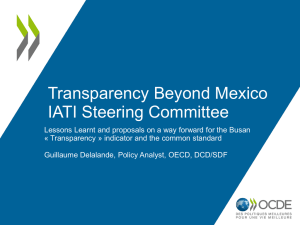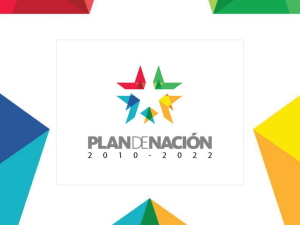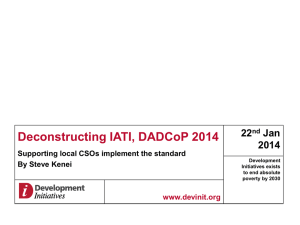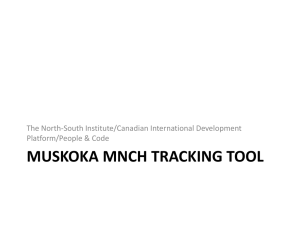International Aid Transparency Initiative - Progress since Accra
advertisement
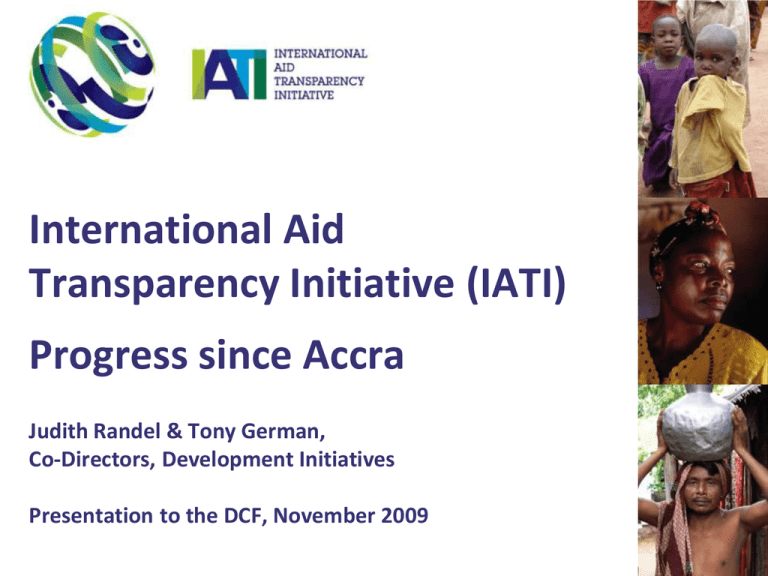
International Aid Transparency Initiative (IATI) Progress since Accra Judith Randel & Tony German, Co-Directors, Development Initiatives Presentation to the DCF, November 2009 Why improve aid transparency? • Information is power and transparency is fundamental to all 5 aid effectiveness principles: – Ownership: everyone needs good information to plan, budget and to involve citizens – Alignment: better information is critical for getting aid on budget and aligned behind country plans – Harmonisation: donors need better information about each others’ plans to harmonise – Mutual accountability: better information will increase accountability between donors & partners, and to citizens – Results: we need better information on inputs to be able to effectively monitor outputs and outcomes What is the International Aid Transparency Initiative (IATI) ? • A multi-stakeholder initiative which aims to bring about a quantum leap in access to info on resource flows in order to increase the effectiveness of aid in reducing poverty • IATI is a way of delivering on Accra commitments on transparency and making aid work better. The AAA says: ‘Donors will publicly disclose regular, detailed and timely information on volume, allocation and, when available, results of development expenditure to enable more accurate budget, accounting and audit by developing countries.’ • IATI can play a keyrole in contributing the work of WP-EFF Cluster C task team on transparency and predictability and adds value to what we already have in the DAC/CRS. • IATI is open to any country that wants to join and sign up to Accra IATI statement Who is involved ? • Full IATI membership: 18 donor signatories and 10 partner countries who have endorsed IATI so far • Multi-stakeholder Steering Committee comprises: Australia, Betteraid, Burkina Faso, Civicus, Colombia, Development Gateway, Development Initiatives, Dominican Republic, EC, Germany, Ghana (tbc), Indonesia, Malawi, Nepal, Netherlands, PNG, PWYF, Rwanda, TI, UNDP, UK, Vietnam (tbc), World Bank. • Multi-stakeholder Technical Advisory Group (TAG) to advise on IT and systems issues. • Partner country consultation led by UNDP • CSO consultation led by Reality of Aid Network • Secretariat: DFID, UNDP, DIPR • Funding: Netherlands, Ireland, Finland, Switzerland, UK, Germany (tbc), plus indirect support from Gates and Hewlett What aid information do people want? • • • • • • Partner countries want timely, up-to-date and reliable information on current and future aid flows; More detailed info on where money is spent (geographical coding), when it is spent, by whom, on what. All info already known and on somebody’s computer. Better coverage of all aid flows from all providers: all governmental donors, multilateral agencies, global funds, foundations and NGOs; Information on conditions, and information to help monitor Paris targets, results and impact; Strategy, policy and evaluation documents. The priorities for CSOs were: info on conditionality, aid commitments and actual disbursements, project impact and complete project documentation What aid information is accessible? • Although a good deal of the information users want is already available, especially from the DAC & CRS databases, but also from OCHA’s FTS and country level databases, for many users especially in developing countries, data is hard to access, there are inconsistencies between multiple systems, there are big gaps and information is not up to date. • Additional information is held in donors’ internal systems but is not publicly available; • Donors are involved in parallel reporting (eg to DAC and to country-level Aid Management Systems), and face multiple ad hoc requests for information at HQ and country-level; • None of the current systems meet the needs of all users, and a one-size-fits-all solution is not the answer. IATI: a common standard for aid information • IATI will support and and value to existing systems like the DAC and AIMS, not undermine or duplicate them; • IATI will NOT create a new mega-database – instead, it will develop a four-part standard for publishing aid information, consisting of: 1) agreement on what will be published; 2) common definitions for sharing information ; 3) a common electronic data format; 4) a code of conduct. If the information is standardised (items 2 and 3 above) it can be ‘published’ in any document and on any website and still be accessible and useable. • The underlying principle is publish once, use many times Benefits of this approach • Donors will publish their aid information once – in a form which enables it to be accessed and applied by many different users, rather than responding individually to multiple requests; • Partner countries will have access to more up-to-date information on current and future aid allocations which can be adapted to individual needs (budget categories, FYs) and access to raw information – this strengthens aid management, budgeting and planning; • Parliamentarians and CSOs will benefit from increased access to more detailed and timely data to demand accountability and they can track aid through to beneficiaries • Automated data exchange has the potential to reduce transaction costs on both sides • Information intermediaries will be able to collect data automatically and offer a wider range of tailor-made services. How does IATI relate to the DAC/CRS? • DAC/CRS does an excellent job in meeting its mandate – to share information amongst donors and to help them hold each other accountable. But it was not designed to meet the needs of partner country stakeholders . – CRS is focused on high quality, verified statistics. But these take time to produce and partner countries need more up to date information – CRS is focused on past aid flows, not current or future flows – CRS doesn’t include qualitative information e.g. conditions, – Information not reported at the project level – It’s only DAC donors and it’s only ODA • Both CRS and IATI are needed: – CRS provides statistics for a specific purpose – IATI will enable publication of information to a wider range of users, including aid managers and implementers and those seeking to demand accountability – IATI standards have the potential to be used by all aid providers – IATI includes qualitative information – IATI will build on CRS standards to meet a wider set of needs IATI Process to date – consultation still open • Accra – Sept 09 – 6 regional partner country consultations covering 74 partner countries – 5 regional CSO consultations covering 160 CSOs – Technical analysis on scope of IATI standards (what will be published) and code of conduct – Preliminary technical work on how information might be published • October 09 – IATI Conference in The Hague – 170 participants from stakeholder organisations – strong support from partner countries, caution from some donors on level of ambition – Incremental progress is still progress Next Steps • Consultation deadline on part 1 of the standard - what is published - 16th November • Steering Committee meeting 30th November to discuss comments on proposals • TBC – physical meeting of Steering Committee plus all IATI signatories in late January to agree final list of what is to be published • Code of conduct now postponed until later in process • Scaling up in 2010: – Formats and definitions (parts 2 and 3 of standard) – Accessibility and capacity building – Donor outreach www.aidtransparency.net www.aidinfo.org
